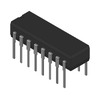Manufacturer Part Number
DG441BDN-T1-E4
Manufacturer
Vishay Siliconix
Introduction
The Vishay Siliconix DG441BDN-T1-E4 is a high-performance quad SPST normally-closed analog switch designed for a wide range of applications, including data acquisition, instrumentation, and industrial control systems. With its low on-state resistance, fast switching speed, and excellent isolation characteristics, this switch offers reliable and efficient signal switching capabilities.
Product Features and Performance
Quad SPST normally-closed analog switch
Low on-state resistance of 80 Ohm (max)
Channel-to-channel matching of 2 Ohm
Fast switching speed with 220 ns turn-on and 120 ns turn-off times
Wide supply voltage range of 13 V to 36 V (single) or ±7 V to ±22 V (dual)
Low charge injection of -1 pC
Low channel capacitance of 4 pF (off-state)
Low leakage current of 500 pA (max)
Excellent crosstalk performance of -95 dB at 100 kHz
Operating temperature range of -40°C to 85°C
Product Advantages
Reliable and efficient signal switching capabilities
Compact surface mount package (16-VQFN Exposed Pad)
Suitable for a wide range of applications, including data acquisition, instrumentation, and industrial control systems
Key Reasons to Choose This Product
High-performance and versatile analog switch solution
Excellent electrical characteristics for reliable signal switching
Compact and easy-to-integrate package
Suitable for a wide range of applications
Quality and Safety Features
Adherence to industry-standard quality and safety requirements
Robust design for reliable operation in various environments
Compatibility
Compatible with a wide range of electronic systems and control applications
Application Areas
Data acquisition systems
Instrumentation and test equipment
Industrial control and automation
Product Lifecycle
The Vishay Siliconix DG441BDN-T1-E4 is an active product, and there are no immediate plans for discontinuation. However, customers should check with our website's sales team for the latest product availability and lifecycle information, as well as any potential equivalent or alternative models that may be available.





 DG428DJSILICONIX
DG428DJSILICONIX DG428DN-E3Vishay
DG428DN-E3Vishay DG441DJHarris CorporationIC SWITCH SPST-NCX4 85OHM 16DIP
DG441DJHarris CorporationIC SWITCH SPST-NCX4 85OHM 16DIP DG441BDYVishay SiliconixIC SWITCH SPST-NCX4 80OHM 16SOIC
DG441BDYVishay SiliconixIC SWITCH SPST-NCX4 80OHM 16SOIC DG441CYAnalog Devices Inc./Maxim IntegratedIC SWITCH SPST-NCX4 85OHM 16SOIC
DG441CYAnalog Devices Inc./Maxim IntegratedIC SWITCH SPST-NCX4 85OHM 16SOIC DG428DJ-E3Vishay SiliconixIC MUX 8:1 100OHM 18DIP
DG428DJ-E3Vishay SiliconixIC MUX 8:1 100OHM 18DIP DG428DNVishay SiliconixIC MUX 8:1 100OHM 20PLCC
DG428DNVishay SiliconixIC MUX 8:1 100OHM 20PLCC DG441DJRenesas Electronics America IncIC SWITCH SPST-NCX4 85OHM 16DIP
DG441DJRenesas Electronics America IncIC SWITCH SPST-NCX4 85OHM 16DIP DG441DJ-ABIAnalog Devices / Maxim Integrated
DG441DJ-ABIAnalog Devices / Maxim Integrated DG441DJAnalog Devices Inc./Maxim IntegratedIC SWITCH SPST-NCX4 85OHM 16DIP
DG441DJAnalog Devices Inc./Maxim IntegratedIC SWITCH SPST-NCX4 85OHM 16DIP